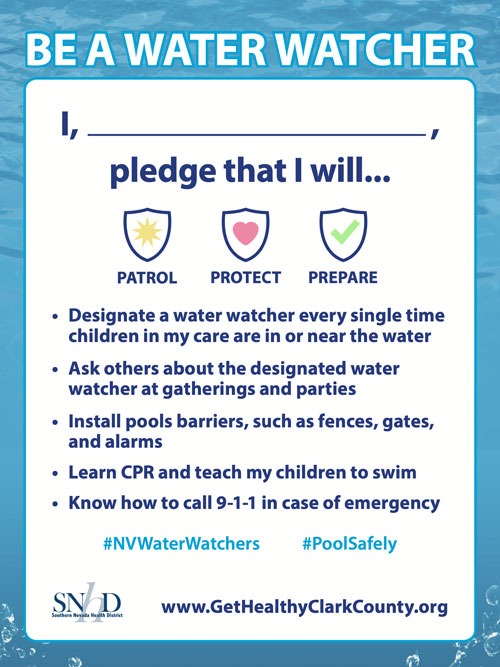Drowning Prevention
Be a Water Watcher
Drownings can be prevented
- In Clark County, most drownings occur among children ages 1-4 years.
- The majority of drowning deaths occur in residential pools.
- More data can be found on our drowning statistics.
A drowning can occur in seconds, in any water that can cover a child’s nose and mouth including:
- Pools
- Spas
- Inflatable pools
- Bathtubs
- Toilets
- Buckets
- Natural bodies of water (lakes, rivers, etc.)
Patrol
 Most tragedies occur in seconds, the time it takes to:
Most tragedies occur in seconds, the time it takes to:
- Answer the phone
- Grab a towel
- Check in on social media
Always designate an adult to actively watch children in the water to prevent drowning.
Patrol Tips:
- Designate an adult to actively watch children in the water.
- Teach all children to get out of the water if a supervising adult leaves the pool area.
- Ask others about the designated Water Watcher at gatherings and parties.
- Hire a certified lifeguard for pool parties, or social gatherings around water.
- Remain close to your child when in a pool, spa or bathtub.
Protect
 Installing four-sided pool fencing, door alarms, locks and other safety measures provide defensive barriers between your child and the pool.
Installing four-sided pool fencing, door alarms, locks and other safety measures provide defensive barriers between your child and the pool.
Layers of protection include:
- Perimeter fences that are non-climbable, four-sided and a minimum of 60 inches high.
- Self-closing, self-latching fence gates with latches mounted above the reach of small children and that open away from the pool.
- When a pool is not in use, gates must be locked with a combination lock so small children cannot get the key to open.
- Gates must be self-closing and never propped open.
- Alarm or secure doggie doors.
- Alarmed doors and windows leading to a pool to alert family members when opened.
- Moving tables, chairs and planters away from pool fence so they cannot be used for climbing over the fence.
Visit the Southern Nevada Pool Code webpage for the full list of pool safety requirements.
Prepare
 Create a plan ahead of time by enrolling your child in swimming lessons, taking CPR classes and ensuring every Water Watcher knows how to call 9-1-1 in case of an emergency.
Create a plan ahead of time by enrolling your child in swimming lessons, taking CPR classes and ensuring every Water Watcher knows how to call 9-1-1 in case of an emergency.
Easy Ways to Prepare:
- Enroll children in age-appropriate, year-round swim lessons taught by qualified instructors to maintain swimming skills. Non-swimming family members should also take lessons. Create a safe pool environment by:
- Requiring all Water Watchers to know CPR, and how to call 9-1-1.
- Taking refresher courses to help maintain CPR skills.
- Having rescue equipment (such as a lifesaving ring, shepherd’s hook, etc.) accessible and in good repair.
- Placing toy boxes away from the pool so children are not tempted to go into the pool area unsupervised.
- Requiring children and non-swimmers to wear US Coast Guard-approved personal flotation devices around any body of open water (PFD or life jacket).
For more drowning prevention information and resources visit the Consumer Product Safety Commission’s webpage.
Video Resources
Pool Safety: Drain Covers
Piscina Segura: Cubiertas de Seguridad para Desagües.
Updated on: May 28, 2024 11:15 am

